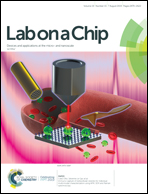Automated “pick and transfer” of targeted cells using dielectrophoresis
Abstract
Selective manipulation of single cells is an important step in sample preparation for biological analysis. A highly specific and automated device is desired for such an operation. An ideal device would be able to selectively pick several single cells in parallel from a heterogeneous population and transfer those to designated sites for further analysis without human intervention. The robotic manipulator developed here provides the basis for development of such a device. The device in this work is designed to selectively pick cells based on their inherent properties using dielectrophoresis (DEP) and automatically transfer and release those at a transfer site. Here we provide proof of concept of such a device and study the effect of different parameters on its operation. Successful experiments were conducted to separate Candida cells from a mixture with 10 μm latex particles and a viability assay was performed for separation of viable rat adipose stem cells (RASCs) from non-viable ones. The robotic DEP device was further used to pick and transfer single RASCs. This work also discusses the advantages and disadvantages of our current setup and illustrates the future steps required to improve the performance of this robotic DEP technology.

- This article is part of the themed collection: Lab on a Chip Emerging Investigators


 Please wait while we load your content...
Please wait while we load your content...